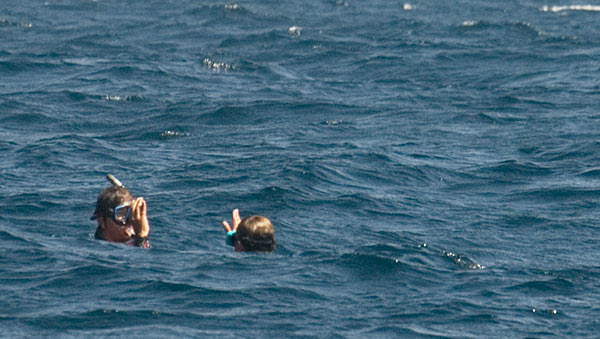MAKING OF
PILOT WHALES
It took a bit of patience and maneuvering before we were able to film Atlantic Pilot Whales. After they eluded us repeatedly, by moving away or diving off, we had the luck of having them come directly before our camera. We kept filming them as long as our air supply lasted. When we finally came up to the surface, Bernd Nies took this photograph:

© Bernd Nies / Michael Weyhers and Daniele Grieco in the straits
When we resumed filming underwater we had an alarming experience. A huge male pilot whale suddenly charged at cameraman Michael Weyhers and then flipped into a standing positing on its head and started to spin around and around, making agitated noises. Pilot bull whales can grow up to 10 feet long and weigh three tons, so this was a breath-taking moment, and we really didn't know what to think -- until the whale turned around with its tail fin extended and flailing.
Cameraman Michael Weyers was almost struck. You can see the shot in the film where the forceful swipe of the tail fin comes within centimeters of the camera lens. The force of the tail swipe nearly knocked the camera out of Michael's hands. Had the tail struck Michael, it could have caused him serious or even fatal injury. While the big whale continued its dance of rage, skipper Herwarth Voigtmann steered the diving boat to separate us from the whale and hauled us out of the water. After a brief pause in filming, the skipper told us, "Now get back in the water and show them who you are!" So we went back underwater and astonishingly, the aggressive behavior of the whales vanished. They seemed to understand that we were posing no threat. Now, all of a sudden, they were playing and flirting with us and staring with curiosity at us at close range. Even the calves came within touching distance and mimicked the bubbling of our snorkels, by blowing bubbles themselves! It was as though we suddenly had been taken into their family. Nonetheless, a pair of large bulls kept surveillance from a short distance.
Anzeige
